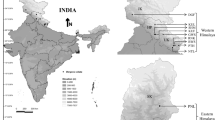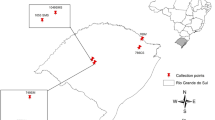Abstract
Genetic variation and clonal diversity of nine populations of Bromus ircutensis Kom. from the Otingdag sandy land were investigated using Inter Simple Sequence Repeat (ISSR) markers. A total of 102 bands were amplified by using 11 ISSR primers chosen for the study. Among those 99% were polymorphic indicating high level of genetic variation at the species level with a mean genetic diversity (H) of 0.292 and Shannon information index (I) of 0.450. Percentage of polymorphic loci (PPL) of nine populations was 76.48% on average, which provides more evidence of considerable genetic variation at the population level. AMOVA analysis revealed that total genetic variation was higher within populations (87.06%) than between populations (12.94%), which is mainly the result of the extensive gene flow (Nm = 1.682) among B. ircutensis populations. UPGMA cluster analysis divided the nine populations into two groups. There was significant or moderate negative correlations between genetic diversity parameters (PPL, H, I) and longitude or latitude. Mantel test also showed a significant correlation between geographical distance and genetic distance (r = 0.681, p = 0.002). Our findings indicated that distribution of B. ircutensis populations was influenced by geographical and ecological factors. Clonal diversity was also high with 108 individuals identified by 11 ISSR primers being all of different genets. Our results provide a molecular basis for sustainable management and conservation of B. ircutensis in the study area.
Similar content being viewed by others
References
Frankham, R., Effective Population Size/Adult Population Size Ratios in Wildlife: A Review, Genet. Res., 1995, vol. 66, pp, 95–107.
Hamrick, J.L. and Nason, J.D., Consequences of Dispersal in Plants, Population Dynamics in Ecological Space and Time, Rhodes, O.E.J., Chesser, P.K., and Smith, M.H., Eds., Chicago: Univ. Chicago Press, 1996, pp. 203–236.
Loveless, M.D. and Hamrick, J.L., Ecological Determinants of Genetic Structure in Plant Populations, Annu. Rev. Ecol. Syst., 1984, vol. 15, pp. 65–95.
Ingvarsson, P.K., The Effect of Delayed Population Growth on the Genetic Differentiation of Local Populations Subject to Frequent Extinctions and Recolonizations, Evolution, 1997, vol. 51, pp. 29–35.
Schnabel, A., Nason, J.D., and Hamrick, J.L., Understanding the Population Genetic Structure of Gleditsia triacanthos L.: Seed Dispersal and Variation in Female Reproductive Success, Mol. Ecol., 1998, vol. 7, pp. 819–823.
Parks, J.C. and Werth, C.R., A Study of Spatial Features of Clones in a Population of Bracken Fern, Pteridium aquilinum (Dennstaedticaceae), Am. J. Bot., 1993, vol. 80, pp.537–544.
Sipes, S.D. and Wolf, P.G., Clonal Structure and Patterns of Allozyme Diversity in the Rare Endemic Cycladenia humilis var. jonesii (Apocyanaceae), Am. J. Bot., 1997, vol. 84, pp. 401–409.
Pornon, A., Escaravage, N., Thomas, P., and Taberlet, P., Dynamics of Genotypic Structure in Clonal Rhododendron ferrugineum (Ericaceae) Populations, Mol. Ecol., 2000, vol. 9, pp.1099–1111.
Escaravage, N., Questiau, S., and Pornon, A., et al., Clonal Diversity in a Rhododendron ferrugineum L. (Ericaceae) Population Inferred from AFLP Markers, Mol. Ecol., 1998, vol. 7, pp.975–982.
Montalvo, A.M., Conard, S.G., Conkle, M.T., and Hodgskiss, P.D., Population Structure, Genetic Diversity, and Clone Formation in Quercus chrysolepis (Fagaceae), Am. J. Bot., 1997, vol. 84, pp.1553–1564.
Kemperman, J.A. and Barnes, B.V., Clone Size in American Aspens, Can. J. Bot., 1976, vol. 54, pp.2603–2607.
Widen, B., Cronberg, N., and Widen, M., Genotypic Diversity, Molecular Markers and Spatial Distribution of Genets in Clonal Plants, a Literature Survey, Folia Geobot. Phytotax., 1994, vol. 29, pp.245–263.
Hsiao, J.Y. and Rieseberg, L.H., Population Genetic Structure of Yushania niitakayamensis (Bambusoideae, Poaceae) in Taiwan, Mol. Ecol., 1994, vol. 3, pp.201–208.
Gabrielsen, T.M. and Brochmann, C., Sex after All: High Levels of Diversity Detected in the Arctic Clonal Plant Saxifraga cernua Using RAPD Markers, Mol. Ecol., 1998, vol. 7, pp.1701–1708.
Esselman, E.J., Jiangqiang, L., Crawford, D.J., et al., Clonal Diversity in the Rare Calamagrostis porteri ssp. insperata (Poaceae): Comparative Results for Allozymes and Random Amplified Polymorphic DNA (RAPD) and Inter Simple Sequence Repeat (ISSR) Markers, Mol. Ecol., 1999, vol. 8, pp.443–451.
Ainsworth, E.A., Tranel, P.J., Drake, B.G., and Long, S.P., The Clonal Structure of Quercus geminata Revealed by Conserved Microsatellite Loci, Mol. Ecol., 2003, vol. 12, pp.527–532.
Van der Velde, M., During, H.J., Van de Zande, L., and Bijlsma, R., The Reproductive Biology of Polytrichum formosum: Clonal Structure and Paternity Revealed by Microsatellites, Mol. Ecol., 2001, vol. 10, pp.2423–2434.
Li, A. and Ge, S., Genetic Variation and Clonal Diversity of Psammochloa villosa (Poaceae) Detected by ISSR Markers, Ann. Bot., 2001, vol. 87, pp.585–590.
Ma, Y.Q., Flora of Inner Mongolia, Hohhot: Inner Mongolia People’s Press, 1994, vol. 5, p. 104.
Editorial Committee of Flora of China, Chinese Academy of Sciences, Flora of China, Beijing: Science Press, 2002.
Song, C.Y., Guo, K., and Liu, G.H., Relationships between Plant Community’s Species Diversity and Soil Factors on Qtingdag Sandy Land, Chin. J. Ecol., 2008, vol. 27, pp.8–13.
Chu, Y., He, W.M., Liu, H.D., et al., Phytomass and Plant Functional Diversity in Early Restoration of the Degraded, Semi-Arid Grasslands in Northern China, J. Arid Environ., 2006, vol. 67, pp.678–687.
He, Q. and Lu, D.R., Monitoring Vegetation Cover Change in East Hunshandake Sandy Land with Land-sat TM and ETM+ and Its Possible Causes, Remote Sensing Technol. Appl., 2003, vol. 18, pp.353–359.
Zha, Y. and Gao, J., Characteristics of Desertification and Its Rehabilitation in China, J. Arid Environ., 1997, vol. 37, pp.419–432.
Yang, X., Ding, Z., Fan, X., et al., Processes and Mechanisms of Desertification in Northern China during the Last 30 Years, with a Special Reference to the Hunshandake Sandy Land, Eastern Inner Mongolia, Catena, 2007, vol. 71, pp, 2–12.
Mi, Y.J., Shi, E.L., and Tian, Q.S., Germination Conditions on Soil Surface and Its Effect on Seedling Growth of Bromus ircutensis, Chinese J. Grassland, 2009, vol. 31, pp.71–75.
Li, J.H. and Li, Q.F., A Study on Heat Tolerance of two Bromus Species during Seed Germination, J. Arid Land Resour. Environ., 2001, vol. 15, pp.102–105.
Wang, D.J., Shi, F.L., Li, Z.L., et al., Study on the Seed Vigor and Drought Resistance of Three Perennial Forages Belong to Bromus under PEG Stress, Seed, 2009, vol. 28, pp.31–34.
Liu, H.D., Yu, F.H., He, W.M., et al., Are Clonal Plants More Tolerant to Grazing than Co-Occurring Non-Clonal Plants in Inland Dunes?, Ecol. Res., 2007, vol. 22, pp.502–506.
Liu, H.D., Yu, F.H., He, W.M., et al., Clonal Integration Improves Compensatory Growth in Heavily Grazed Ramet Populations of Two Inland-Dune Grasses, Flora, 2009, vol. 204, pp.298–305.
Tian, Q.S., Han, B., and Yang, J., et al., Genetic Diversity Analysis of 96 Brome Materials Based on ISSR Markers, Chinese J. Grassland, 2010, vol. 32, pp, 18–25.
Ao, Y.H., Pei, H., Wang, Y.L., and Li, Y.P., Monitoring on Land Cover Dynamics of Hunshandake Sandland by Remote Sensing, J. Desert Res., 2010, vol. 30, pp.33–39.
Zheng, Y.R., Xie, Z.X., Robert, C., et al., Did Climate Drive Ecosystem Change and Induce Desertification in Otindag Sandy Land, China over the Past Years?, J. Arid Environ., 2006, vol. 64, pp, 523–541.
Sambrook, J. and Russell, D.W., Molecular Cloning,: A Laboratory Manual, Cold Spring Harbor: Cold Spring Harbor Lab., 2001, 3rd ed.
Yeh, F.C., Yang, R.C., and Boyle, T., POPGENE. Microsoft Windows-Based Freeware for Population Genetic Analysis: Release 1.31, Edmonton: Univ. Alberta, 1999.
Rohlf, F.J., NTSYS-pc: Numerical Taxonomy and Multvariate Analysis System: Version 2. I. User Guide, Setauket: Exeter Software, 2004.
Excoffier, L., Laval, G., and Schneider, S., ARLEQUIN ver. 3.1: An Integrated Software Package for Population Genetics Data Analysis, Bern: Bern Univ., 2006.
Ellstrand, N.C. and Roose, M.L., Patterns of Genotypic Diversity in Clonal Plant Species, Am. J. Bot., 1987, vol. 74, pp.123–131.
Fager, E.W., Diversity: A Sampling Study, Am. Naturalist, 1972, vol. 106, pp.293–310.
Eckert, C.G. and Barrett, S.C.H., Clonal Reproduction and Patterns of Genotypic Diversity in Decodon verticillatus (Lythraceae), Am. J. Bot., 1993, vol. 80, pp.1175–1182.
Zhao, Q.F., Wang, G., and Li, Q.X., Genetic Diversity of Five Kobresia Species along the Eastern Qinghai-Tibet Plateau in China, Hereditas, 2006, vol. 143, pp.33–40.
Harald, A., Barbara, N., Friderike, E., et al., Demographic and Random Amplified Polymorphic DNA Analyses Reveal High Levels of Genetic Diversity in a Clonal Violet, Mol. Ecol., 2001, vol. 10, pp.1811–1819.
Torimaru, T., Tomaru, N., Nishimura, N., and Yamamoto, S., Clonal Diversity and Genetic Differentiation in Ilex leucoclada M. Patches in an Old-Growth Beech Forest, Mol. Ecol., 2003, vol. 12, pp.809–818.
Gill, D.E., Chao, L., Perkins, S.L., and Wolf, J.B., Genetic Mosaicism in Plants and Clonal Animals, Annu. Rev. Ecol. Syst., 1995, vol. 26, pp.423–444.
Eriksson, O., Clonal Life Histories and the Evolution of Seed Recruitment, The Ecology and Evolution of Clonal Plants, de Kroon, H. and van Groenendael, J., Eds., Leiden; Backhuys Publ., 1997, pp.211–226.
Renner, S.S., Tropical Trans-Atlantic Disjunctions, Sea Surface Currents, and Wind Patterns, Int. J. Plant Sci., 2004, vol. 165,suppl. 4, pp.s23–s33.
Gottschling, M., Diane, N., Hilger, H.H., and Weigend, M., Testing Hypothesis on Disjunctions Present in the Primarily Woody Boraginales: Ehretiaceae, Cordiaceae, and Heliotropiaceae, Inferred from ITS, Sequence Data, Int. J. Plant Sci., 2004, vol. 165,suppl. 4, pp.s123–s135.
Zhao, G.G., Felber, F., and Kuepfer, P., Subpopulation Differentiation of Anthoxanthum alpinum (Poaceae) along an Altitudinal Gradient Detected by Random Amplified Polymorphic DNA, Acta Phytotaxon. Sin., 2000, vol. 38, pp.64–70.
Maki, M., Morita, H., Oiki, S., and Takahashi, H., The Effect of Geographic Range and Dichogamy on Genetic Variability and Population Genetic Structure in Tricyrtis Section Flavae (Liliaceae), Am. J. Bot., 1999, vol. 86, pp.287–292.
Wolfe, A.D. and Liston, A., Contributions of PCR-Based Methods to Plant Systematics and Evolutionary Biology, Molecular Systematics of Plants: II. DNA Sequencing, Soltis, D.E., Soltis, P.S., and Doyle, J.J., Eds., New York: Chapman and Hall, 1998, pp.43–86.
Author information
Authors and Affiliations
Corresponding author
Additional information
The article is published in the original.
Rights and permissions
About this article
Cite this article
Yu, T., Han, B., Tian, Q. et al. Genetic variation and clonal diversity of Bromus ircutensis Kom. in the Otingdag sandy land detected by ISSR markers . Russ J Genet 47, 703–710 (2011). https://doi.org/10.1134/S1022795411060172
Received:
Published:
Issue Date:
DOI: https://doi.org/10.1134/S1022795411060172




